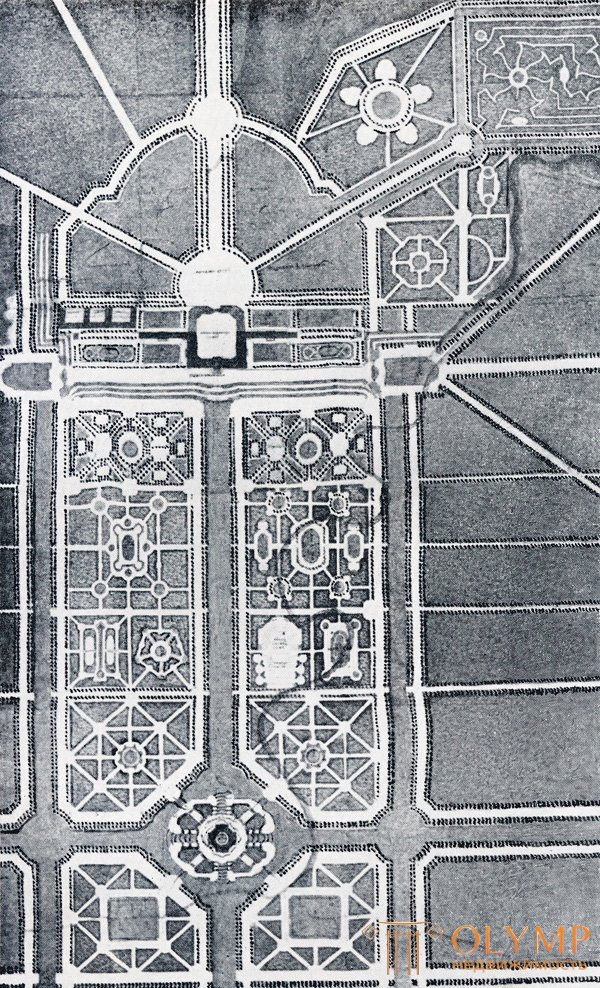
The ensemble is located 20 km from Leningrad. The total area of the park complex is 140 hectares, the area of the regular garden is 40 hectares.
The choice of land on the river. The arrow by the sea was made by Peter I, taking into account the proximity of the sea, the peculiarities of the natural relief and the rich water resources of the area. The first drawing was made by Peter I. The park construction work was carried out according to the project of Peter I. V. Rastrelli, J. Leblon, S. Chipriani, N. Michetti and others participated in the further development of the project.
In the period from 1717 to 1719, work is underway on the project (and under the direction of) Leblond, which was based on the already partially implemented network of channels. According to the project, the palace was located on the edge of the upper terrace, towering 12 m above the flat marshland. Between canals boskets, fountains, park facilities were designed, and on the central channel along the axis of the palace on the island was provided the “Water Castle” (artificial hill with a pavilion on top) . The slope of the palace terrace was decorated in a wide cascade. Concentration in one place of the palace, the terraces and the cascade met the requirements of Peter, who was striving to achieve greater expressiveness. At the southern facade of the palace was designed a vast water parterre with three beams of driveways. The palace with a grotto and a cascade was founded in 1720.
The palace consisted of a main building with a belvedere turret, two outbuildings and a gallery of colonnades stretched 100 meters in length and terminated in pavilions. With all subsequent changes to the palace, its important landmark was preserved - three high arches of the main building, forming a through passage to the park's terrace, in the frame of which its landscapes are perceived.
By 1725, the following works were carried out: the palace was basically completed, canals were dug, a road network was laid in the poured area of the lower terrace, and lanes, bosquets, and bersoes were planted. Standard trees (alder, linden, maple, elm) or trellis (linden and maple) were used in the alleys. Arbors, stairs on the terraces were built, an orchestra was laid, decorated with flower beds of bulbous trees and spruce trees, “cropped pyramids”. Conifers grew on the terraces. A swimming pool was set up in the Upper Garden and oaks, willows, maples were planted.
In the 1710s, to the west of the regular garden, an economic complex was created with a fruit orchard, a greenhouse and the Aleksandrovsky pond (6 hectares) intended for drainage of the area and fish farming.
All this time, the design and construction of the park are under the constant control of Peter. The Strelna Ensemble was conceived as the main front residence, which, with its grandeur, pomp and ideological interpretation, had to underline the power of the Russian Empire as a great maritime power.
The Strelna Palace and Park Ensemble is the only one of its kind “water garden”. Three wide mirror axes of the canals, filled with water to the level of the paths, lead from the palace to the sea. The middle channel, laid along the axis of the palace, ends with a round island. Here Leblon supposed to arrange a “Water Castle”, however, on the orders of Peter I, the island remained flat. Here he personally planted pines, the seeds of which were collected in the Harz. The central part of the island was free from plantings, which made it possible to reveal the perspective of the Gulf of Finland along the canal’s mirror framed by pine trees. Thus, Peter I included the natural landscape in the park ensemble. The western and eastern canals went out to the sea in order to provide access from the sea to the palace on ships. Monumentality (even some static) of the water surface of the canals, wide alleys, bosquets and extensive parterres was supposed to be enhanced by the noisy brilliance of the water devices of the palace cascade and the garden fountains.
The water supply system was developed and practically implemented under Peter I. In 1719–20. R. The arrow was taken to the Western Canal, and a part of the old channel was turned into a system of ponds (thus, the Orlovsky pond was created by the dam of the Strelka River, the excess water was discharged into the port channel).
After the death of Peter I, construction stops. In the subsequent to Strelna periodically returned. In 1751–1758 works V. Rastrelli, whose project improves the channels, at the ends of the transverse axis, going past the grotto, construct a stone gate.
In 1792, a new stage in the life of the park began, connected with the development of the landscape style direction. During the war, the palace was destroyed, the plantings in the Upper Park destroyed. In 1949 the palace was restored. In the western part of the Lower Park in the 80s, the old plantings were completely replaced and the road network was restored. Restoration works are ongoing (authors I. Bogovaya and A. Gromov).
Что бы оставить комментарий войдите
Комментарии (0)